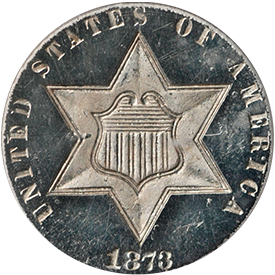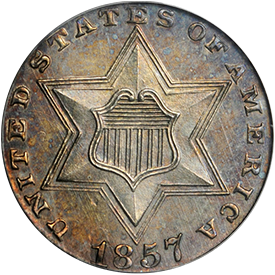The tiny three-cent silver piece, or “Trime” appeared in 1851 and was one of the more unique denominations made by the United States. They were the first coin struck for circulation without an image of Miss Liberty on the obverse as well as being struck from a low silver content alloy of only 75% when they were originally introduced.
The United States introduced postage stamps in 1847, and the rates for domestic mail were either five, or ten cents, depending on the distance. This rate was lowered to three cents in 1851 and it was believed that the new coin would facilitate the purchase of postage stamps. Additionally, it was noted that a large denominational gap existed between the Large Cent and the Half Dime – keeping in mind of course that prices 175 or so years ago were far lower than today, and that a few cents had real buying power.
The three-cent silver piece had three minor design changes throughout its 22-year life. The first type showed no outline to the star, and as mentioned earlier, was struck from a low-grade silver alloy. The second type, introduced in 1854, was a bit lighter in weight, but made with a conventional 90% silver alloy. Two outlines to the star on the obverse were added, as well as an olive sprig and bundle of arrows on the reverse. Finally, in 1859, the star outline was reduced to only one line.
All three-cent silver pieces were struck in Philadelphia with the exception of the first year (1851) where 720,000 pieces were also made in New Orleans. Production dropped sharply after 1862, and nearly all business strike pieces made after 1862 were melted in 1873 when the denomination was discontinued.
Collecting Strategies
For the numismatist who wishes to form a complete collection by dates and major varieties, several possibilities are available. Issues from 1851 through 1862 are readily available in worn grades and exist in approximate proportion to original mintages. Issues after 1862 are seldom seen except in Proof or impaired Proof preservation. Thus, a "budget collection" of silver three-cent pieces could include Fine to Extremely Fine issues from 1851 through 1862, but dates from 1863 through 1873 would necessarily have to be in higher states of preservation. Although issues such as 1867, 1868, 1869, and other dates of the era posted nominal business strike or circulation mintages, in practice such coins are extreme rarities today. It is probably the case that years can elapse between offerings of a well-worn 1868 silver three cent piece, although the value of such a coin is not apt to be great. For practical purposes, as noted, Proofs or impaired Proofs will have to be obtained.
If budget is not a consideration, then the deluxe way to go is to assemble a set of Proofs from 1858 (the first year such were sold to collectors) through 1873. Issues from 1851 through 1857 can be acquired in Uncirculated preservation. Hard to find in this grade will be 1851-O, 1854, 1855, 1856, and 1857, with 1856 being particularly rare. Examples of the Type II design in sharply struck Uncirculated condition will be nearly impossible to locate, so some compromise will be necessary in this regard. Scattered Proofs exist prior to 1858 and are major rarities and quite nice to acquire. However, they should not be insisted upon as a requirement for completion. Certain "Proofs" offered of earlier dates might not be Proofs at all. Occasionally, polished coins which have been heavily toned are offered as Proofs. If you are not sure of the coin, be sure of the dealer from whom you acquire it or better yet, stick with certified examples.
Beginning with a mintage of 210 Proofs in 1858, examples were sold to the general public. Mintages soon increased, and by 1860 a figure of 1,000 Proofs was posted. However, the Mint practice was to make such coins to put them "on the shelf," for possible sale to collectors. The true story is that many of them, sometimes substantial portions of the entire mintage, went to the melting pot. By 1862 Proof mintage had dwindled to just 550 pieces. This was due to two main reasons. First, the Mint realized the true demand and started producing pieces in quantities that were more realistic in view of actual sales. Second, during the middle of the Civil War the Mint posted a requirement that United States paper money could not be used to purchase coins! Indeed, coins sold at a premium in terms of paper money. So, it was necessary to pay for Proof coins by submitting the payment in other silver or gold coins, thus making it difficult to order such pieces easily.
In general, Proofs after the early 1860s, continuing through 1873, exist today in approximate proportion to the mintages. If, for example, one assumes that the mintage of 600 Proofs for 1869 is correct, then it is logical to estimate that perhaps a couple hundred were lost, strayed, or stolen and cannot be traced today, leaving, say, 400 pieces in numismatic hands. Of these pieces, in theory probably 100 to 200 (at most) are in grades that can be described as Proof-63 or Proof-65 (Select Proof or Choice Proof) today. The other 200 or so show impairment or cleaning. In particular, cleaning has been the great enemy of Uncirculated and Proof coins, commemorative coins, and other pieces which have attracted the attention of investors in recent decades. Many investors believe that "brilliant is best," with the result that a typical coin has made several trips through the coin cleaning process during the past 20 or 30 years. One dipping or cleaning might be fine, for such may simply transform a toned coin to a bright one, without ill effects. However, repeated dipping removes each time some metal from the coin's surface, finally resulting in a cloudy product.
Are you building a type set7 Then you have three pieces to acquire among silver three-cent issues, one each of the Type I, II, and III designs. If you are building a set in circulated condition, then among Type I issues you can have your pick of 1851, 1852, or 1853. All are readily available, although the 1851 is slightly scarcer. 1851-O is scarcer yet and may be appealing as it is the only mintmark issue of the denomination. In Uncirculated condition you will find that 1851, 1852, and 1853 are readily available but, again, 1851 is slightly scarcer. 1851-O is very rare in strictly Uncirculated preservation.
Type II pieces are readily available in worn grades. Uncirculated issues are rare, and sharply struck Uncirculated pieces are exceedingly so. However, if your requirement is to have just one Type II silver threecent piece of the 1854-1858 years, perhaps with some looking you can eventually acquire one which is both sharply struck and Uncirculated. It will require some patient hunting, however.
Type III pieces can be obtained in all grades. Worn examples from 1859 through 1862 are readily available. Although catalogues list such grades as Good and Very Good, these did not circulate to a great extent, so the average piece encountered is apt to be Fine or better. Uncirculated coins are available for the same dates, with 1861 and 1862 being those usually seen. As noted earlier, 1859, although it has a mintage higher than 1862, is much rarer – probably at least 50 times rarer in Uncirculated condition! Proofs of the Type III design are readily available. You might enjoy the satisfaction of having one of the lowmintage issues of the late 1860s or early 1870s. Typically, these cost little more than a Proof of the 1859-1862 years.










